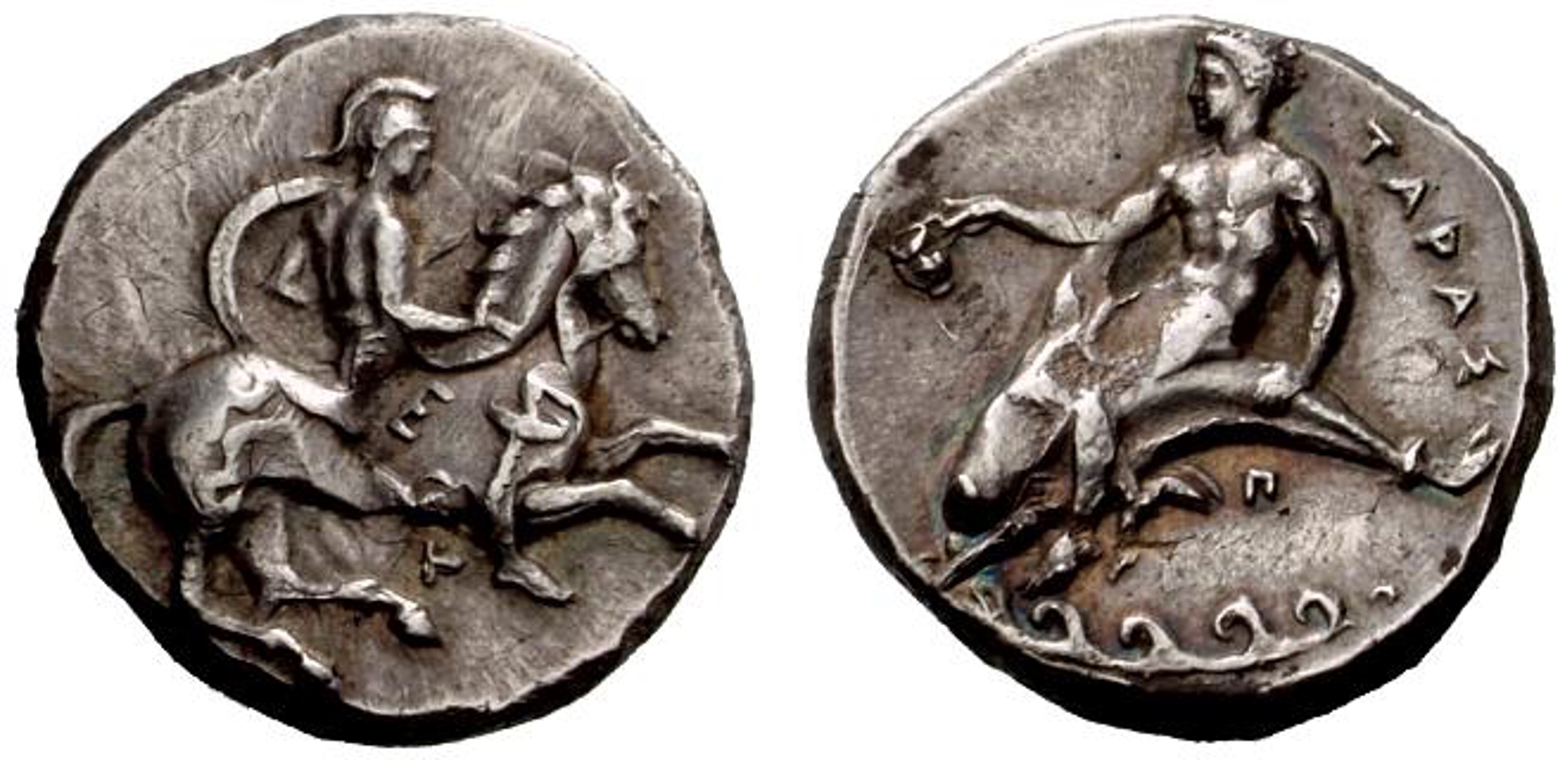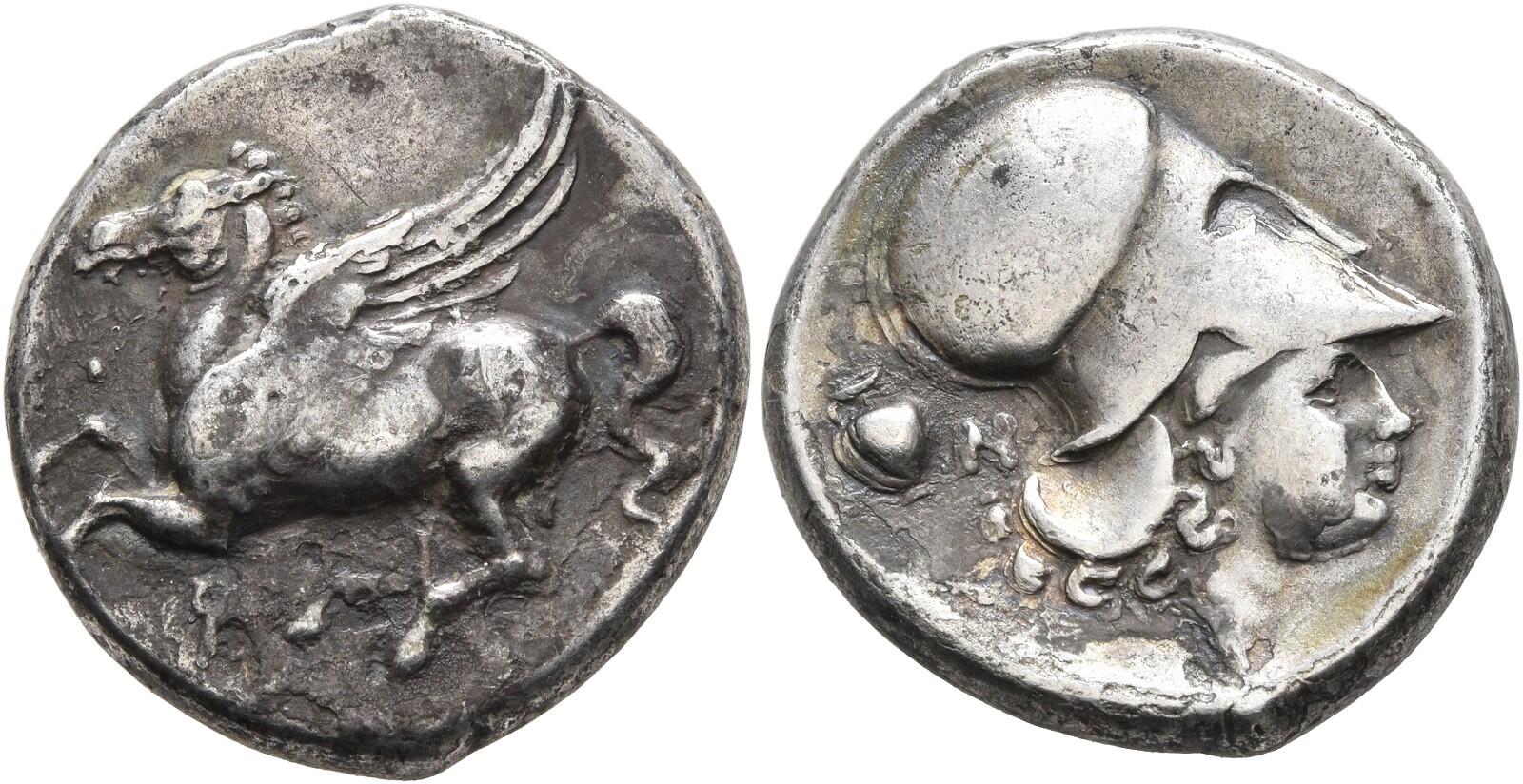345 BCE - 340 BCE | TAPAΣ
Overstriking coin
2434 - Taras (AR nomos) over Corinth.jpg
[1]
Overstruck variety
Taras on Corinth - Heritage, 3037, 4 Jan. 2015, 29885 overstruck variety.jpg
[2]
|
|
Sale(s)Sale(s) ᵖ:
|
Numismatica Ars Classica, 29, 11 May 2005, 20 = Triton, XXXIII, 14 Jan. 2020, 10
|
|
|
|
Description
| ObverseInscription or printing placed on the obverse.:
|
Male character seated on horse galloping to right, naked, wearing helmet, holding reins in one hand and shield and spear in other. Below, E.
|
ReverseInscription or printing placed on the reverse.:
|
TAPAΣ (Greek) Male character (Taras or Phalanthos), nude, seated sideways on a dolphin to left, holding cantharos. Below, Π over wave pattern.
|
Mint and issuing power
| MintIdentifies the place of manufacture or issue of a numismatic object.:
|
Taras
|
Ancient regionAncient region.
|
Calabria
|
Modern countryModern country: Italy
|
AuthorityIdentifies the issuing power. The authority can be "pretended" when the name or the portrait of X is on the coin but he/she was not the issuing power. It can also be "uncertain" when there is no mention of X on the coin but he/she was the issuing power according to the historical sources:
|
|
Chronology
| FromIdentifies the initial date in a range assigned in a numismatic context. 345 BCE toIdentifies the final date in a range assigned in a numismatic context.. 340 BCE
|
Classical 480-323 BC  periodTime period of the numismatic object. periodTime period of the numismatic object.
|
Physical description
MetalThe physical material (usually metal) from which an object is made.: Silver 
|
WeightWeight of the numismatic object (in grams). in grams: 7.957.95 g <br />7,950 mg <br />
|
DenominationTerm indicating the value of a numismatic object. Examples: tetradrachm, chalkous, denarius.: nomos
|
|
|
|
|
References
| Coin referenceReference of the Coin:
|
Garraffo 1982, pl. 1, 5, Fischer-Bossert 1999, Group 48, n° 672a
|
Coin series referenceReference to coin series study:
|
Ravel 19471Ravel 1947, n° 448 (this obverse die), SNG ANS 2 Lucania2SNG ANS 2 Lucania, n° 396 (these dies), Garraffo 19823Garraffo 1982, pl. 1, n° 5, Fischer-Bossert 19994Fischer-Bossert 1999, Group 48, n° 672a, HN Italy5HN Italy, n° 890, HGC 16HGC 1, n° 776
|
| Coin series web referenceCoin series web references:
|
|
Description
| ObverseInscription or printing placed on the obverse.:
|
Pegasus flying
|
ReverseInscription or printing placed on the reverse.:
|
Head of Athena right, wearing Corinthian helmet
|
Mint and issuing power
| MintIdentifies the place of manufacture or issue of a numismatic object. ᵖ:
|
Corinth
|
Ancient regionAncient region. ᵖ
|
Peloponnesus
|
Modern countryModern country: Greece
|
AuthorityIdentifies the authority in whose name (explicitly or implicitly) a numismatic object was issued. ᵖ:
|
|
Chronology
| FromIdentifies the initial date in a range assigned in a numismatic context. 400 BCE toIdentifies the final date in a range assigned in a numismatic context.. 340 BCE
|
Classical 480-323 BC  periodTime period of the numismatic object. periodTime period of the numismatic object.
|
Physical description
| DenominationTerm indicating the value of a numismatic object. Examples: tetradrachm, chalkous, denarius. ᵖ:
|
stater 
|
|
|
References
References
- a b Ravel, Oscar E. (1990), Descriptive catalogue of the collection of Tarentine coins formed by M. P. Vlasto, London, Spink
- ^ Troxell, Hyla S. (1972), Sylloge Nummorum Graecorum: The collection of the American Numismatic Society. Part 2. Lucania, New York
- ^ Garraffo, Salvatore (1982), "Per la cronologia dei 'Cavalieri' tarantini dei periodi I-IV Evans", Rivista Italiana di Numismatica v. LXXXIV, p. 101-127, 1 pl.
- ^ Fischer-Bossert, Wolfgang (1999), Chronologie der Didrachmenprägung von Tarent, 510-280 v. Chr., Berlin, De Gruyter, xvii, 495 p., [84] pl.
- ^ Rutter N. Keith et alii (eds.) (2001), Historia Numorum Italy, London, xvi, 223 p., 43 pl.
- ^ Hoover, Oliver D. (2018), The Handbook of Greek Coinage Series, Volume 1. Handbook of Coins of Italy and Magna Graecia, Sixth to First Centuries BC., Lancaster-London, 2018, lxi, 527 pages, 23 cm
- ^ Calciati, Romolo (1990), Pegasi, Mortara, Edizioni I.P..

